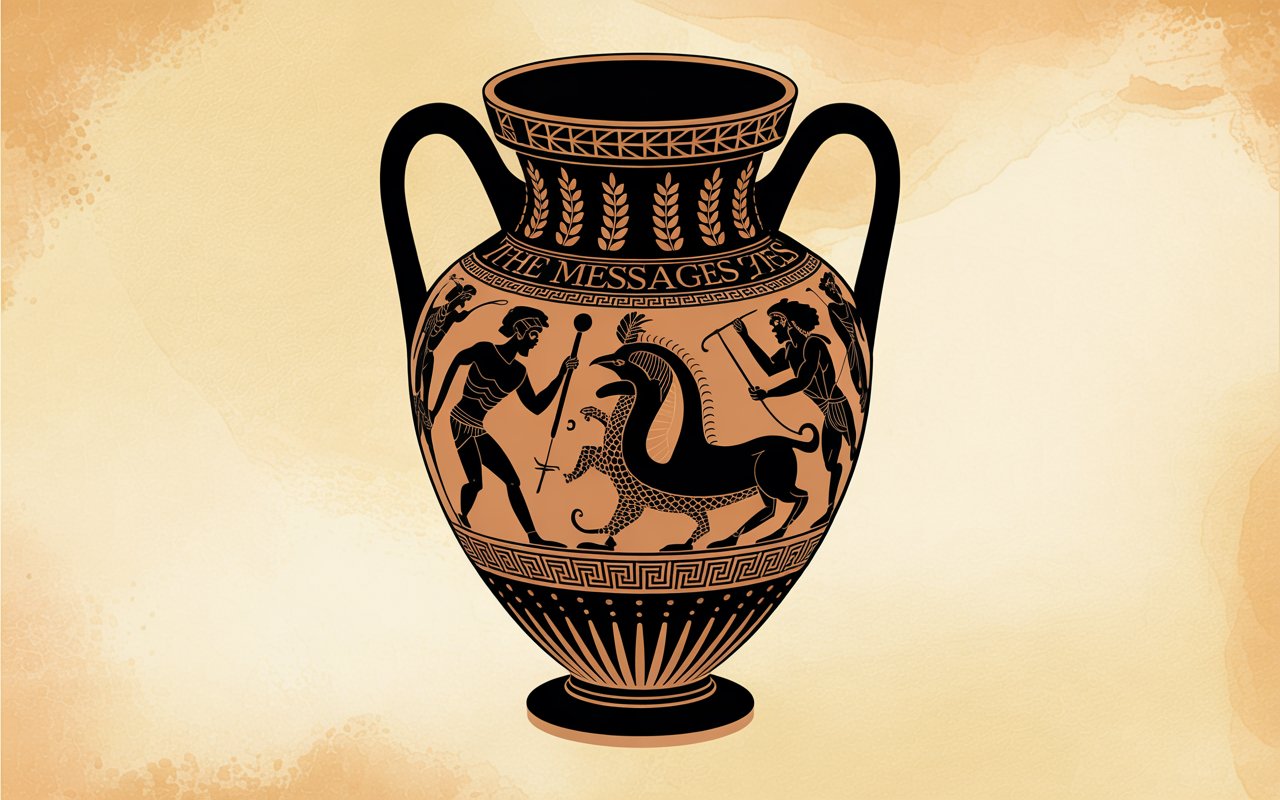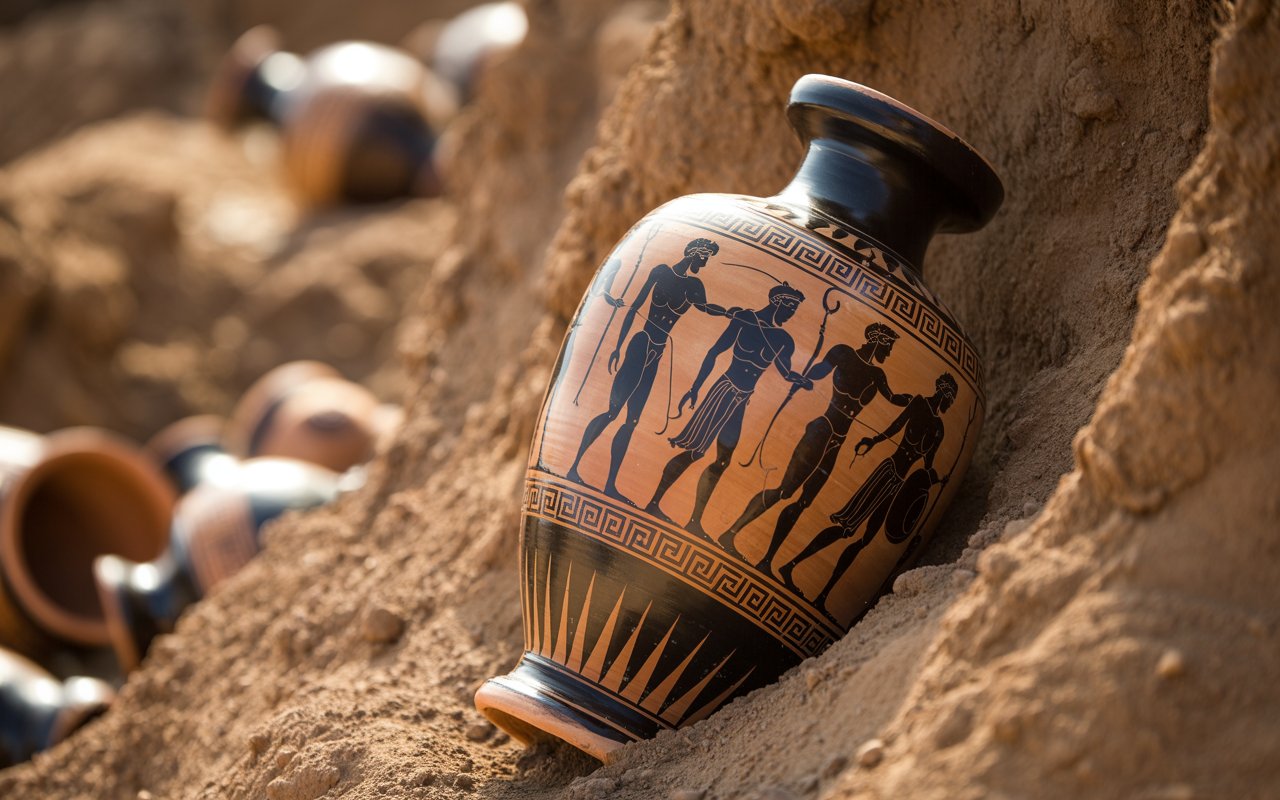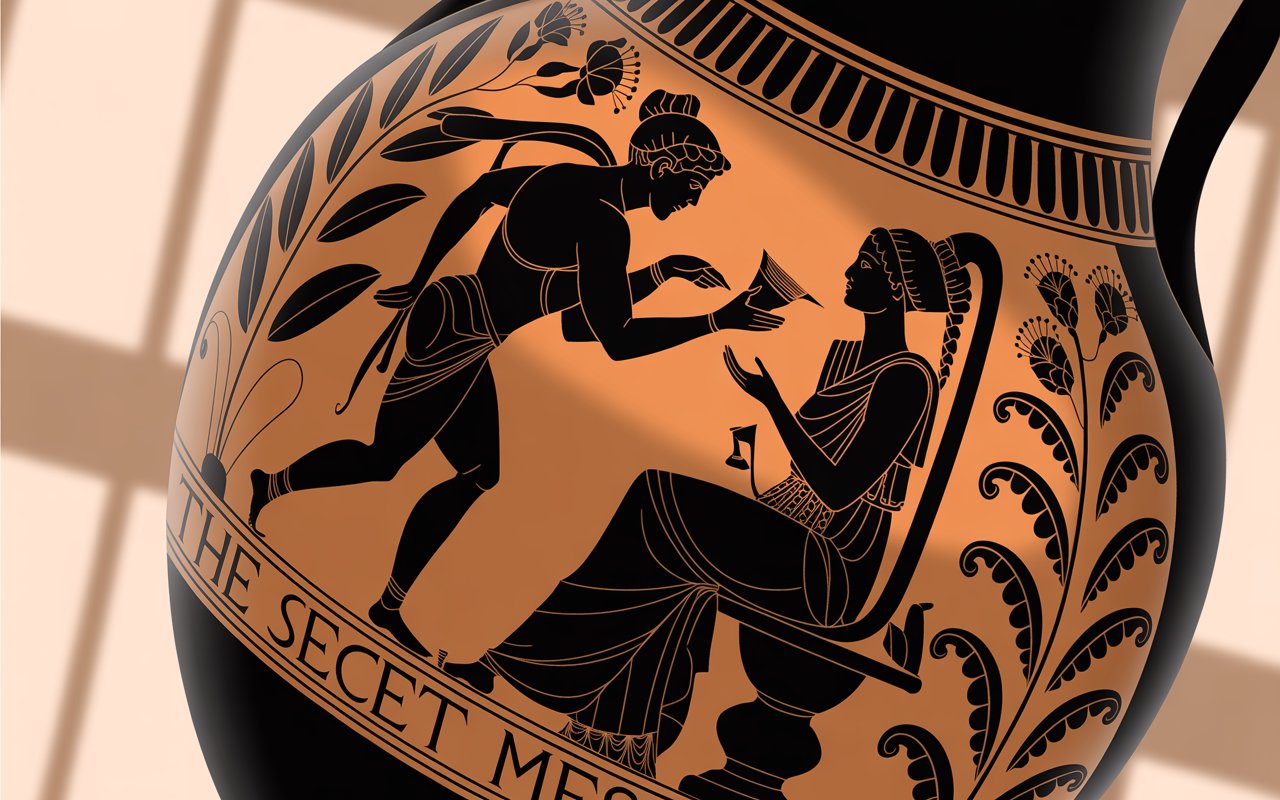Unknown Greek Facts: The Secret Messages Hidden in Greek Pottery
What if your favourite coffee mug could tell stories for millennia? Ancient Greek artisans achieved precisely this with their pottery, blending practicality with vivid storytelling. Between 1000 and 400 BC, these everyday objects doubled as time capsules, preserving myths, rituals, and glimpses of Mediterranean life through intricate designs.
Far from mere containers, these vessels acted as cultural archives. Their painted scenes revealed everything from heroic legends to market-day chatter, offering insights no written record could match. Recent studies using X-ray scanning techniques have uncovered hidden layers of pigment, exposing clever production methods lost for centuries.
You’ll discover how symbols on wine jugs or oil jars conveyed social status. Learn why certain colours held religious meaning. See how modern science helps decode patterns that even ancient users might’ve missed.
This isn’t just about dusty museum pieces. Each pot whispers secrets about real people – their beliefs, jokes, and daily struggles. Ready to hear what they’ve been saying for 2,500 years?
Discovering Secret Messages Hidden in Greek Pottery
Ever wondered how everyday objects could share complex ideas without words? Ancient artisans transformed clay vessels into visual encyclopaedias, using symbols that spoke volumes to those who understood their code. These designs weren’t random decorations – they formed a sophisticated language connecting communities across the Mediterranean.
Decoding the Visual Language
Look closely at a wine cup’s surface. That owl isn’t just decoration, it’s Athena’s signature. Lions leaping across amphorae shouted tales of heroism. Through repeated use, these symbols became cultural shorthand. Even geometric patterns held meaning, with meander designs echoing eternal life.
Understanding the Cultural Clues
Modern researchers piece together puzzles using burial sites and temple records. A warrior scene near Athens might celebrate local victories, while Dionysian imagery on drinking cups reinforced religious beliefs. Colours mattered too – black figures often depicted mortals, while reddish hues hinted at divine presence.
Next time you spot these vessels in museums, play detective. Notice how figures interact, are gods towering over humans? Does a plant motif match harvest rituals? Each detail whispers about values that shaped daily life. You’re not just seeing art, you’re reading a civilisation’s diary.
The Art and Technique of Ancient Greek Pottery
Have you ever held a clay mug that’s lasted decades? Imagine one surviving 2,500 years. That’s the legacy of Attic clay – the ancient world’s premium material for crafting durable vessels. Its high iron content gave finished pieces their signature orange red glow, while natural minerals ensured strength that modern ceramics still envy.
Crafting with Attic Clay
Potters didn’t sculpt whole jars in one go. They built them like 3D puzzles, throwing separate sections on wheels before joining them with clay slip. This technique allowed precise control over curves and thickness. A master could make a wine jug’s neck narrower than your thumb while keeping its belly perfectly rounded.
Traditional Firing and Painting Methods
The real magic happened in the kiln. Craftsmen used urine or vinegar to fix pigments during three-stage firings. “You’d smell the workshop before seeing it,” laughs Dr Helena Markos, a ceramics historian. Black designs came from mixing potash with iron oxide – a recipe requiring exact temperatures. Too hot, and colours turned muddy; too cool, and they’d flake off.
Modern artists struggle to replicate these results. The ancient Greeks balanced chemistry and artistry in ways we’re still unpacking. Next time you admire their work, remember – each brushstroke survived because someone perfected ash, clay, and heat like a concert conductor.
Everyday Life and Ceremonial Use in Ancient Greece
Imagine uncovering a 2,500 year old diary that chronicles both grocery lists and sacred rituals. That’s precisely what ancient ceramics offer – snapshots of daily life alongside spiritual practices. Artisans painted bustling market scenes, weaving workshops, and even cheeky children’s games onto jugs and bowls used in homes.
Depictions of Daily Activities
Look closely at a hydria (water jar), and you might spot women chatting at a fountain. Storage jars often showed families harvesting olives, while drinking cups captured athletes mid leap. These scenes weren’t just decoration, they documented routines from dawn till dusk.
Even household items taught social values. A child’s bowl might feature alphabet practice, reinforcing education’s importance. Cooking pots displayed recipes through painted ingredients, acting as early cookbooks.
Pottery in Religious and Festival Ceremonies
Special vessels bridged earthly and divine realms. Lekythoi held perfumed oil for anointing statues during festivals. Massive kraters mixed water and wine for Dionysian celebrations, their decorations mirroring the revelry.
Victorious athletes received prize amphorae filled with sacred olive oil, the ancient equivalent of trophies. Meanwhile, funerary vases depicted mourners alongside mythological scenes, blending personal grief with shared beliefs.
Whether holding sacred oils or party drinks, these objects show how ancient Greek culture intertwined practicality with spirituality. Your morning coffee mug suddenly seems rather underachieving, doesn’t it?
Evolution of Greek Pottery Styles
Can you trace a civilisation’s growth through its tableware? Between 1050-400 BCE, ceramic styles transformed from basic patterns to intricate storytelling canvases. This 600-year journey mirrors artistic experimentation and cultural exchange across the Mediterranean.
From Geometric to Archaic Designs
Early Proto-geometric works (1050-900 BCE) kept things simple, think concentric circles and wavy lines. By 900 BCE, Geometric designs took over with zigzags and angular meanders. These bold patterns didn’t just decorate surfaces, they signalled growing confidence in craftmanship.
The Archaic period brought a revolution. Potters began framing mythological scenes with floral borders around 700 BCE. Suddenly, jars showed chariot races alongside funeral processions, turning functional objects into history books.
Black-Figure versus Red-Figure Techniques
Black-figure pottery dominated from the 7th century BCE. Artists painted silhouetted figures onto red clay, scratching details with needles. But by 530 BCE, the red-figure pottery technique flipped this approach, leaving figures red and painting backgrounds black instead.
This clever inversion allowed finer brushwork. Suddenly, muscles rippled and drapery flowed realistically. As archaeologist Maria Georgiou notes: “The shift from black to red figures wasn’t just technical, it reflected society’s hunger for detailed storytelling.”
Today, these styles help experts date finds. That wine cup with thick black figures? Likely pre-500 BCE. One with delicate red scenes? Probably from Athens’ golden age. Your local museum likely has both – go spot the differences!
Modern Scientific Insights with X-ray Scanning
What if we could peel back centuries like layers of paint? Advanced imaging technologies now let researchers do exactly that. A 2,500 year old Athenian oil flask recently revealed its secrets through synchrotron X-ray fluorescence, exposing craftsmanship tricks lost for millennia.
Synchrotron X-ray Fluorescence Techniques
This method works like a supercharged scanner for ancient objects. By mapping chemical elements in the paint, it uncovers hidden production steps. The Athenian flask showed calcium-based additives in white pigments, a detail invisible to human eyes for 2,500 years.
Revealing Hidden Layers of Paint
Traditional views assumed simple painting methods. But scans prove artists layered colours strategically. “We’re seeing revisions and touch-ups,” explains Dr Eleanor Vickers from the British Museum. “It’s like finding draft versions beneath a finished masterpiece.”
These discoveries rewrite pottery history. Craftsmen likely used multiple firings to fix complex designs. Conservation teams now apply these insights to protect fragile vase surfaces during restoration.
Next time you admire ancient ceramics, remember: their full story might still be emerging. Modern science keeps adding chapters to these silent narratives.
The Influence of Greek Mythology on Pottery Narratives
Myths leapt from campfire tales to clay surfaces, becoming society’s ultimate picture books. Artisans transformed everyday vessels into storytelling devices, etching legends that shaped cultural identity. These weren’t mere decorations, they were visual lessons in morality and divine power.
Icons of Gods, Heroes and Legends
Spot Athena by her owl companion or Zeus by his lightning bolt. Heroes like Heracles flexed muscles battling hydras on wine jugs, while Odysseus outwitted cyclops on storage jars. Each figure served as a recognisable character in ongoing sagas.
These scenes did more than entertain. A youth studying a cup’s painted labours learned perseverance. A family gathering around a krater saw teamwork modelled through Argonaut adventures. Greek mythology became tangible through fired clay.
Symbolism and Hidden Meanings
Look beyond obvious stories. A dolphin symbolised safe voyages; an olive branch hinted at Athena’s favour. Even animals carried layered messages, lions for strength, hares for fertility.
Artists cleverly stacked narratives. A single vase might show Heracles’ childhood antics at the base and his apotheosis near the rim. As Dr. Lydia Papadakis notes: “The best pieces work like comic strips – your eye follows the hero’s journey.”
Through these designs, pottery became society’s textbook. Myths stayed alive across generations, their lessons baked into objects people used daily. Your cereal bowl suddenly seems underachieving, doesn’t it?
The Process Behind Greek Vase Production
Ever watched a potter spin clay into symmetrical perfection? Ancient craftsmen achieved this daily, transforming raw earth into storytelling masterpieces. Their workshops buzzed with specialists, wheel, throwers, painters, and kiln masters collaborating like a well-oiled machine.
From Shaping to Finishing Touches
Potters built vessels like 3D puzzles. They’d craft the body, neck, and foot separately on wheels, then bond them with clay slip. “You’d see them constantly returning to the wheel,” notes ceramics historian Dr Ian Wallace. “Smoothing seams until the joins became invisible.”
Once shaped, pieces went to painters working in shared studios. These artists weren’t lone geniuses – they operated under master craftsmen, producing hundreds of vases annually. Records show some decorated over 200 pieces in their careers.
Quality control was fierce. Workshops maintained strict standards for proportions and decoration. A single misfired batch could ruin a studio’s reputation. This pressure bred innovation, secret glaze recipes and firing tricks guarded like state secrets.
Next time you admire these ancient vessels, remember: each handle and curve represents countless hours of collaboration. From clay preparation to final brushstroke, they’re testaments to teamwork across generations.
Interpreting Ancient Narratives Through Designs
Ever tried deciphering a comic strip without words? That’s essentially what scholars do when analysing Greek pottery scenes. These visual tales follow deliberate patterns, key figures placed centrally, actions flowing left to right like text. Your eye naturally follows the story as ancient artists intended.
Reading Stories Embedded in Art
Start by spotting recurring symbols. A warrior raising a spear might signal victory, while clasped hands often denote alliances. Scenes frequently use frame-breaking techniques – a chariot wheel protruding beyond borders creates movement. “It’s visual theatre,” notes Oxford researcher Dr James Whitaker. “Every element serves the plot.”
Context transforms your understanding. A dancing figure could represent a wedding ritual or Dionysian revelry, depending on accompanying symbols. Modern exhibitions often display shards alongside complete works, showing how specialists reconstruct fragmented stories.
These designs weren’t just decoration, they educated across social classes. A servant carrying wine might mirror their master’s heroic pose, suggesting shared cultural values. Even painting styles conveyed meaning: bold outlines for clarity, overlapping figures showing depth.
Today’s researchers compare multiple scenes to spot variations in popular myths. You’ll find Achilles’ legend changes subtly between regions, like regional accents in storytelling. Next time you visit a museum, see if you can spot these narrative tricks – you’re decoding ancient bestsellers.
Greek Pottery in the Modern Artistic Landscape
Ancient craftsmanship meets modern creativity in studios and museums across the globe. Contemporary artists reimagine classical forms, blending 2,500 year old styles with fresh perspectives. From ceramicists reviving black figure techniques to architects echoing amphora curves in steel structures, these creations prove timeless design transcends eras.
Museums play a crucial role in this dialogue. The British Museum’s digital tours let you examine pottery brushwork from your sofa, while live restoration streams demystify conservation science. Educational programmes use replica vessels to teach geometry through ancient patterns, a clever way to connect past and present.
You’ll spot classical influences in unexpected places. Graphic designers adapt meander motifs for brand logos, and furniture makers reinterpret krater shapes into modern lamps. Even street art murals nod to mythological scenes, proving these visual stories still resonate today.
As 3D printing helps preserve fragile artefacts, new generations discover how ancient pottery shaped our world. Each conserved piece isn’t just saved history, it’s inspiration waiting to spark tomorrow’s masterpieces. The dialogue between old and new continues, one coiled clay vessel at a time.









